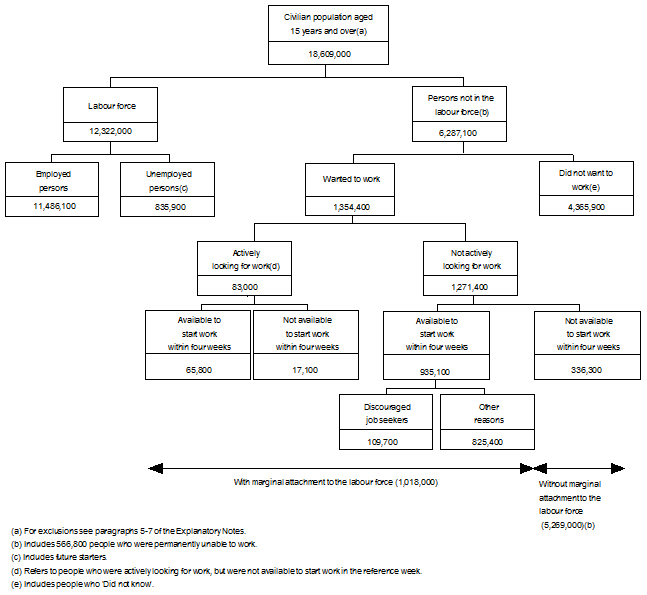CONCEPTUAL FRAMEWORKS
PERSONS NOT IN THE LABOUR FORCE (PNILF) AGED 15 YEARS AND OVER
Persons not in the labour force consists of those who are marginally attached to the labour force, and those who are not. Persons who are marginally attached to the labour force satisfy some, but not all, of the criteria used to classify a person as unemployed.
Persons not in the labour force are considered to be marginally attached to the labour force if they:
- wanted to work and were actively looking for work (but, unlike unemployed people, were not available to start work in the reference week); or
- wanted to work and were not actively looking for work but were available to start work within four weeks.
Persons not in the labour force are not marginally attached to the labour force if they:
- did not want to work; or
- wanted to work but were not actively looking for work and were not available to start work within four weeks.
The following diagram illustrates the framework for PNILF statistics.
 UNDEREMPLOYED WORKERS (UEW)
UNDEREMPLOYED WORKERS (UEW)
The ABS conceptual framework for underemployment separates employed people into two mutually exclusive groups:
- workers who are considered to be fully employed, comprising:
- employed people who worked full-time during the reference week (includes people who usually work part-time);
- employed people who usually work full-time but worked part-time in the reference week for non-economic reasons (including illness or injury, leave, holiday or flextime, and personal reasons); and
- part-time workers (usually work part-time and did so in the reference week) who would not prefer additional hours of work.
- workers who are not fully employed, comprising:
- part-time workers who would prefer to work more hours; and
- full-time workers who worked part-time in the reference week for economic reasons (such as being stood down or insufficient work being available).
Underemployed workers are those who are not fully employed excluding part-time workers who would prefer to work more hours but were not available to work more hours.
The following diagram illustrates the framework for UEW statistics.
JOB SEARCH EXPERIENCE (JSE)
Job Search Experience presents three mutually exclusive groups of the labour force:
- unemployed persons;
- employed persons who started their current job in the previous 12 months; and
- persons employed for more than a year in their current job who looked for work in the previous 12 months.
The following diagram illustrates the framework for JSE statistics.
 Quality Declaration
Quality Declaration  Print Page
Print Page
 Print All
Print All